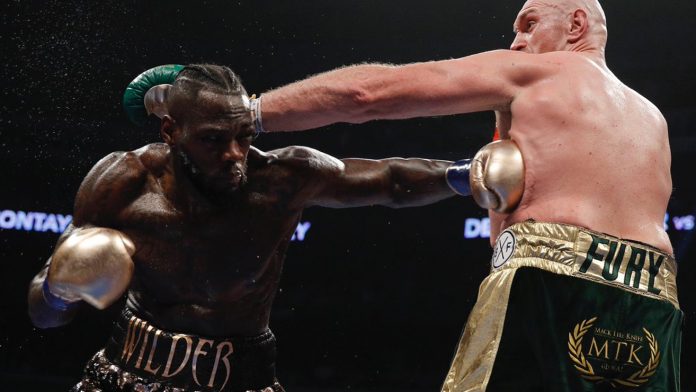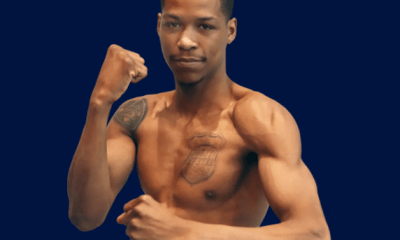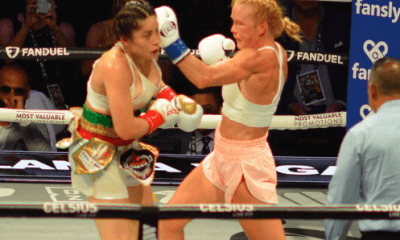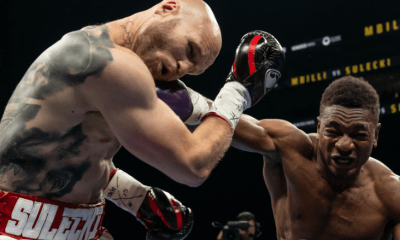Featured Articles
Controversial Wilder – Fury Draw a Case of Déjà Vu All Over Again

The moment ring announcer Jimmy Lennon Jr. revealed the official scoring of Saturday night’s Deontay Wilder-Tyson Fury bout – a controversial split draw in Los Angeles that enabled Wilder, the WBC heavyweight champion who to many people’s way of thinking, including mine, appeared to have received an early Christmas present – I had the feeling I had seen it all before.
And I had, 25 years earlier, on Sept. 10, 1993, in San Antonio, Texas. With one or two minor changes, what took place in the Staples Center ring closely mirrored what transpired in the Alamodome when WBC welterweight titlist Pernell Whitaker was obliged to settle for a hotly disputed majority draw against Julio Cesar Chavez in a heist of a fight which Whitaker appeared to have won handily. In this virtual replay a quarter-century later, British challenger Tyson Fury won – uh, make that should have gotten credit for winning – nine of the 12 rounds in the much-anticipated Showtime Pay Per View matchup, the most notable exceptions to the norm being rounds nine and 12, in which Fury (27-0-1, 19 KOs) was floored by an increasingly desperate Wilder (40-0-1, 39 KOs) who had to be aware his only chance at victory hinged on scoring a late, bolt-from-the-blue knockout. My personal scorecard thus gave Fury a 115-111 edge, the same tally arrived at by unofficial Showtime judge Steve Farhood, a vocal a majority of the 17,698 on-site spectators and, most vociferously, Showtime analyst Paulie Malignaggi.
Although Malignaggi, a former IBF super lightweight and WBA welterweight champion, presumably disagreed with the 113-113 scorecard submitted by the swing judge, England’s Phil Edwards, his most withering criticism was directed at Mexican judge Alejandro Rochin, who somehow saw Wilder as a 115-111 winner. Canadian judge Robert Tapper was the realist of the group, with a 114-112 edge to Fury (originally announced as 114-110).
“I don’t care about any replays,” the exasperated Malignaggi replied when fellow analyst Al Bernstein suggested they check the tape for possible moments that might have negated Fury’s steady stockpiling of rounds and thus allowed Wilder to surprisingly retain his title. “They matter nothing. This decision is a joke. Alejandro Rochin should better never work a day in his life again in boxing.”
The guess here is that Rochin and Edwards will continue to be in the rotation for high-visibility WBC title-fight assignments, as was the case with Switzerland’s Franz Marti and England’s Mickey Vann, both of whom figured that crowd favorite Chavez had done enough to merit a 115-115 standoff in a bout in which the beloved Mexican national hero appeared to have been thoroughly schooled by Whitaker. In tandem they overrode the 115-113 card for Whitaker turned in by Texas-based judge Jack Woodruff, which still was too close to my way of thinking.
But for those who might not go along with my premise that Wilder-Fury was a near-exact replication of Whitaker-Chavez, which did not feature any knockdowns, I offer two other bouts that also reminded me of certain aspects of Wilder-Fury: Bernard Hopkins’ 12th-round stoppage of Felix Trinidad in their middleweight unification fight on Sept. 29, 2001, in Madison Square Garden, and future heavyweight champion Wladimir Klitschko overcoming three knockdowns to register a unanimous, 12-round decision over Samuel Peter on Sept. 24, 2005, in Atlantic City Boardwalk Hall for Peter’s minor NABF title.
Mash those three fights together and the combined result would be, in relation to Wilder-Fury as well as the immortal words of the late, great baseball philosopher Yogi Berra, déjà vu all over again.
Like Chavez, who complained that it was he, not Whitaker, who deserved better than a kiss-your-sister draw because “Sweet Pea” had done “more running that fighting,” Wilder – whose nearly closed window of opportunity momentarily flung wide-open when he drilled Fury in the 12th round with the kind of power shots that had enabled him to win inside the distance 39 previous times – said the two knockdowns he registered should count for more than anything Fury had done in a performance that, on balance, was more impressive than his unanimous-decision dethronement of Wladimir Klitschko three years earlier.
“I think with the two knockdowns, I definitely won the fight,” Wilder said in a post-fight interview with Showtime’s Jim Gray. “You know, we fought our hearts out tonight. We’re both warriors. We both went hand-to-hand, but with those two drops I feel I won the fight.”
That argument was previously trotted out, with no success, by Ivailo Gotzev, Samuel Peter’s manager, who said that his guy’s three knockdowns of Klitschko – two in the fifth round, one in the 10th – trumped the fact that Wlad, with his metronome jab, had dominated virtually every other second of a fight that ended with all three judges favoring him by the same 114-111 margin.
“If a man who scored three knockdowns is declared a loser, to me, that’s no loser,” Gotzev groused. For what it’s worth, there would be a rematch, on Sept. 11, 2010, with Klitschko scoring a 10th-round knockout victory over Peter to retain his IBF and WBO titles in Frankfurt, Germany.
Now let’s flash back to Hopkins-Trinidad, which was presaged by the mind games played by B-Hop – which included his twice disrespecting the Puerto Rican flag at press conferences – and had the effect of so enraging Trinidad that he threw caution to the wind from the opening bell and tried to get the crafty Philadelphian out of there with every loaded-up punch that missed the mark. Hopkins fought superbly and under control until he felt it was time to really let loose, battering his favored opponent to the point that Trinidad’s father-trainer felt he had no choice but to throw in the towel in the 12th round to save his son from further punishment.
Although Wilder had vowed he would pick his spots to go to the heavy artillery against Fury, whose gift is not necessarily in looking good himself but in making the other guy look bad, he seemed to forget whatever strategical refinements laid out for him in camp by trainers Mark Breland and Jay Deas. Swinging wide and wild from the outset, Wilder’s fight plan, whatever it might have been as crafted by Breland and Deas, quickly devolved into pure brawling tactics. It seems a pretty safe bet that Fury’s constant putdowns of him had made the excitable Wilder, well, just a little bit crazy.
“All the build-up for the fight, the hype and everything … I really wanted to get him out of there and give the fans what they wanted to see,” Wilder told Gray. “It was just the simple fact that I was rushing the punches. When I rush my punches like that, they never land. I’m never accurate when I’m trying to force the punches. But the rematch, I guarantee I’m gonna get him.”
And maybe Wilder would, as Klitschko did to Peter in their do-over, if it actually comes to that. But the rematch clause in the contracts signed by Wilder and Fury could only be invoked by Wilder in the case of the loss of his title to Fury, and with the draw that did not happen. Yeah, a rematch with Fury no doubt would do good business, but Wilder and his support crew have to realize – as do Fury and his people – that it would not be a blockbuster on the scale of a fight with WBA/WBO/IBF champ Anthony Joshua.
Although Wilder and Fury both paid obligatory lip service to the notion of an immediate rematch, their thoughts seemed to drift more to a clear-the-decks showdown with Joshua for all the titles, a likely attendance of 90,000 in London’s Wembley Stadium and a super-sized payday beyond anything that even Wilder-Fury II could generate. For his part, Joshua and his promoter, Eddie Hearn, would now seem to have the luxury of picking which of the non-losers, Wilder or Fury, they would most want to share the ring with in what surely would be the most lucrative fight of 2019.
“There’s a third heavyweight out there,” Fury said in referencing the specter of Joshua that hung over the proceedings like a bad moon rising. Then, making clucking sounds, he yelped, “Chicken! Chicken! Joshua, where are ya, AJ?”
Wilder had hoped to use a victory over lineal champion Fury, preferably one ending in another emphatic knockout, as a springboard into the superfight with Joshua he most craves. It now seems reasonable to presume that to safeguard the route to Joshua, Wilder’s team of advisers – that would be promoter Lou DiBella, Premier Boxing Champions honcho Al Haymon and co-trainers Breland and Deas – will think long and hard before consenting to a rematch with Fury, whose difficult-to-solve style did indeed prove to be troublesome to the lean and lanky Alabaman. Despite the public outcry for Whitaker-Chavez II, one fervently shared by Whitaker and his handlers, that fight never happened. Chavez was too valuable a property to be exposed to the kind of risk and potential embarrassment that might have resulted had he again tangled with Whitaker.
Curiously, some of the key figures in Whitaker-Chavez were represented, either live and in person or by extension, at Wilder-Fury. The late Jose Sulaiman was president of the WBC and present in San Antonio that night 25 years ago; at ringside in LA was Sulaiman’s son and successor, Mauricio Sulaiman. And in the house at both widely separated fights was Shelly Finkel, who managed Whitaker then and is an adviser to Wilder now.
There is an old saying: the more things change, the more they remain the same. It’s as true in boxing, and maybe even more so, than in any other area of human existence. The faces and names may be different, but the game remains constant.
Bernard Fernandez is the retired boxing writer for the Philadelphia Daily News. He is a five-term former president of the Boxing Writers Association of America, an inductee into the Pennsylvania, New Jersey and Atlantic City Boxing Halls of Fame and the recipient of the Nat Fleischer Award for Excellence in Boxing Journalism and the Barney Nagler Award for Long and Meritorious Service to Boxing.
Check out more boxing news on video at The Boxing Channel
To comment on this article at The Fight Forum, CLICK HERE
-

 Featured Articles3 weeks ago
Featured Articles3 weeks agoAvila Perspective, Chap. 330: Matchroom in New York plus the Latest on Canelo-Crawford
-

 Featured Articles1 week ago
Featured Articles1 week agoVito Mielnicki Jr Whitewashes Kamil Gardzielik Before the Home Folks in Newark
-

 Featured Articles4 weeks ago
Featured Articles4 weeks agoAvila Perspective, Chap 329: Pacquiao is Back, Fabio in England and More
-

 Featured Articles3 weeks ago
Featured Articles3 weeks agoOpetaia and Nakatani Crush Overmatched Foes, Capping Off a Wild Boxing Weekend
-

 Featured Articles2 weeks ago
Featured Articles2 weeks agoCatching Up with Clay Moyle Who Talks About His Massive Collection of Boxing Books
-

 Featured Articles3 weeks ago
Featured Articles3 weeks agoFabio Wardley Comes from Behind to KO Justis Huni
-

 Featured Articles1 week ago
Featured Articles1 week agoMore Medals for Hawaii’s Patricio Family at the USA Boxing Summer Festival
-

 Featured Articles4 weeks ago
Featured Articles4 weeks agoDelving into ‘Hoopla’ with Notes on Books by George Plimpton and Joyce Carol Oates





















